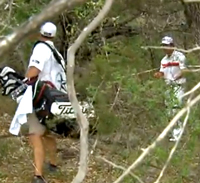The last time the Junior America’s Cup was held in Colorado it was in 1999 at Perry Park Country Club in Larkspur. Prior to the first round a confident young man representing Northern California walked into the golf shop and asked then Head Golf Professional John Merrihew what the course record was. Merrihew told him the long-standing competitive record was 67. Eighteen holes later young Kevin Na walked into the golf shop smiling and handed his scorecard to Mr. Merrihew to be displayed on the wall–he had shot an opening round of 66 to set the course record.
However, the now grown-up Kevin Na recently set a very different record in the opening round of the Valero Texas Open. His first round score of 80 included an unprecedented 16 on the par-4 9th hole.
It all started when he hit his tee shot off line into an area of dense trees. His ball was found, but the lie was so bad he was forced to declare it unplayable (Rule 28), which has three relief options that all include a one stroke penalty. His first option (A) was to go back to the spot from which he played his last stroke, commonly known as stroke and distance. His second option (B) was to drop a ball behind the spot where his original ball lay, keeping this point between him and the hole. And his third option (C) is to take the spot where his ball lies and drop within two club-lengths of this spot, no closer to the hole. Neither option (B) nor (C) provided any practical relief as they only put his ball deeper into the same trouble he was in. So he lifted his ball and headed back to the tee under stroke and distance (option A).
Na played his third stroke from the tee. Unfortunately, this shot looked just like his first tee shot, and the result was the same. But this time he didn’t declare his ball unplayable, and in obvious frustration, made his fourth stroke at it. The ball bounced off of a tree and struck him in the leg bringing Rule 19-2 into play which states that “if a player’s ball is accidentally deflected or stopped by himself, his partner or either of their caddies or equipment, the player incurs a penalty of one stroke”¦and the ball must be played as it lies.” At this point Na was lying 5, and his ball was in another position where he had to declare it unplayable and choose from the same three options referenced earlier. However, since he played his last stroke from in the trees, that spot became his reference point for the first option (stroke and distance). That meant he could no longer go back to the tee, and all of his options involved dropping in the dense wooded area he was stuck in. He felt his best option was (B), so he kept the point where the ball lay between him and the hole and dropped a new ball, now lying 6.
It then took him another 7 strokes (two of them left-handed and one whiff) to get his ball out of the trees. Na was then lying 13 and was about 160 yards from the hole. Like the professional he is, he put his next shot on the green and two-putted to save his rare duodecuple bogey. So rare, in fact, that it stands as the highest score ever recorded on a par-4 in a PGA Tour Event. Only Ray Ainsley’s 19 on the par-4 16th at Cherry Hills CC in the 1938 U.S. Open is higher.
Na’s run-in with the trees, and the Rules of Golf, put him the record books again. Did Na walk into the clubhouse at TPC San Antonio after his practice round and ask, “What’s the highest score on Hole 9 anyone’s ever posted in this event?”
I doubt it.
But I’ll bet a copy of his scorecard is hanging on the wall there, too.


